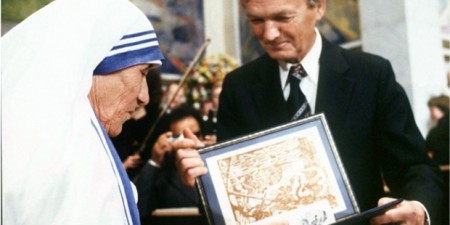Mother Teresa
In 1950 Teresa founded the Missionaries of Charity, a Roman Catholic religious congregation which had over 4,500 sisters and was active in 133 countries in 2012. The congregation manages homes for people dying of HIV/AIDS, leprosy and tuberculosis; soup kitchens; dispensaries and mobile clinics; children's- and family-counselling programmes; orphanages, and schools. Members, who take vows of chastity, poverty, and obedience, also profess a fourth vow: to give "wholehearted free service to the poorest of the poor".[8]
Teresa received a number of honours, including the 1962 Ramon Magsaysay Peace Prize and 1979 Nobel Peace Prize. She was canonised (recognised by the church as a saint) on 4 September 2016, and the anniversary of her death (5 September) is her feast day.
A controversial figure during her life and after her death, Teresa was admired by many for her charitable work. She was praised and criticised for her opposition to abortion, and criticised for poor conditions in her houses for the dying. Her authorised biography was written by Navin Chawla and published in 1992, and she has been the subject of films and other books.


India
Teresa was first recognised by the Indian government more than a third of a century earlier, receiving the Padma Shri in 1962 and the Jawaharlal Nehru Award for International Understanding in 1969.[74] She later received other Indian awards, including the Bharat Ratna (India's highest civilian award) in 1980.[75] Teresa's official biography, by Navin Chawla, was published in 1992.[76] In Kolkata, she is worshipped as a goddess by some Hindus.[77]
To commemorate the 100th anniversary of her birth, the government of India issued a special ₹5 coin (the amount of money Teresa had when she arrived in India) on 28 August 2010. President Pratibha Patil said, "Clad in a white sari with a blue border, she and the sisters of Missionaries of Charity became a symbol of hope to many – the aged, the destitute, the unemployed, the diseased, the terminally ill, and those abandoned by their families."[78]
Indian views of Teresa are not uniformly favourable. Aroup Chatterjee, a physician born and raised in Calcutta who was an activist in the city's slums for years around 1980 before moving to the UK, said that he "never even saw any nuns in those slums".[79] His research, involving more than 100 interviews with volunteers, nuns and others familiar with the Missionaries of Charity, was described in a 2003 book critical of Teresa.[79] Chatterjee criticized her for promoting a "cult of suffering" and a distorted, negative image of Calcutta, exaggerating work done by her mission and misusing funds and privileges at her disposal.[79][80] According to him, some of the hygiene problems he had criticized (needle reuse, for example) improved after Teresa's death in 1997.[79]
Teresa received the Ramon Magsaysay Award for Peace and International Understanding, given for work in South or East Asia, in 1962. According to its citation, "The Board of Trustees recognises her merciful cognisance of the abject poor of a foreign land, in whose service she has led a new congregation".[88] By the early 1970s, she was an international celebrity. Teresa's fame may be partially attributed to Malcolm Mugge ridge's 1969 documentary, Something Beautiful for God, and his 1971 book of the same name. Muggeridge was undergoing a spiritual journey of his own at the time.[89] During filming, footage shot in poor lighting (particularly at the Home for the Dying) was thought unlikely to be usable by the crew. In England, the footage was found to be extremely well-lit and Muggeridge called it a miracle of "divine light" from Teresa.[90] Other crew members said that it was due to a new type of ultra-sensitive Kodak film.[91] Mugge ridge later converted to Catholicism.[92]

